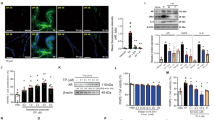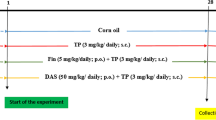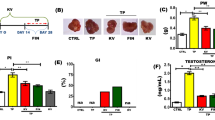Abstract
The growth and development of prostate gland is governed by testosterone. Testosterone helps in maintaining the adipose tissue stores of the body. It is well documented that with advancing age there has been a gradual decline in testosterone levels. Our aim was to study the protective role of daidzein on flutamide-induced androgen deprivation on matrix degrading genes, lipid profile and oxidative stress in Wistar rats. Sub-chronic (60 days) flutamide (30 mg/kg b.wt) administration resulted in marked increase in expressions of matrix degrading genes [matrix metalloproteases 9 and urokinase plasminogen activation receptor]. Additionally, it increased the levels of low density lipoproteins, total cholesterol, triglycerides, and lowered the levels of high density lipoproteins and endogenous antioxidant levels. Oral administration of daidzein (20 and 60 mg/kg b.wt) restituted the levels to normal. Daidzein administration resulted in amelioration of the prostate atrophy, degeneracy and invasiveness induced by flutamide. Our findings suggest that the daidzein may be given as dietary supplement to patients who are on androgen deprivation therapy, to minimize the adverse effects related to it and also retarding susceptibility of patients to cardiovascular diseases.






Similar content being viewed by others
Abbreviations
- AR:
-
Androgen receptor
- BPH:
-
Benign prostatic hyperplasia
- CDNB:
-
1-Chloro 2,4-dinitrobenzene
- CaP:
-
Cancer of prostate
- CAT:
-
Catalase
- CVD’s:
-
Cardiovascular diseases
- DTNB:
-
5,5′-Dithio-bis [2-nitrobenzoic acid]
- EDTA:
-
Ethylenediamine tetra acetic acid
- GR:
-
Glutathione reductase
- GSH:
-
Reduced glutathione
- GSSG:
-
Oxidized glutathione
- HDL:
-
High density lipoprotein
- LDL:
-
Low density lipoprotein
- MMP-9:
-
Matrix metalloproteases 9
- PMS:
-
Post-mitochondrial supernatant
- NADPH:
-
Reduced nicotinamide adenine dinucleotide phosphate
- ROS:
-
Reactive oxygen species
- TG:
-
Triglycerides
- uPAR:
-
Urokinase plasminogen activation receptor
- VP:
-
Ventral prostate
References
Raghow S, Kuliyev E, Steakley M, Greenberg N, Steiner MS (2000) Efficacious chemoprevention of primary prostate cancer by flutamide in an autochthonous transgenic model. Cancer Res 60:4093–4097
Higano CS (2003) Side effects of androgen deprivation therapy: monitoring and minimizing toxicity. Urology 61(2 Suppl 1):32–38
Marin P, Holmang S, Jonsson L, Sjostrom L, Kvist H, Holm G, Lindstedt G, Björntorp P (1992) The effects of testosterone treatment on body composition and metabolism in middle-aged obese men. Int J Obes Relat Metab Disord 16:991–997
Satariano WA, Ragland K, Van Den Eeden S (1998) Cause of death in men diagnosed with prostate carcinoma. Cancer 83:1180–1188
Lu-Yao G, Stukel TA, Yao SL (2004) Changing patterns in competing causes of death in men with prostate cancer: a population based study. J Urol 171:2285–2290
Sprenkle P, Fisch H (2007) Pathologic effects of testosterone deprivation. Curr Opin Urol 17:424–430
Saigal CS, Gore JL, Krupski TL, Hanley J, Schonlau M, Litwin MS (2007) Androgen deprivation therapy increases cardiovascular morbidity in men with prostate cancer. Cancer 110:1493–1500
Zou Z, Zeng F, Xu W, Wang C, Ke Z, Wang QJ, Deng F (2012) PKD2 and PKD3 promote prostate cancer cell invasion via uPA by shifting balance between NF-κB and HDAC1. J Cell Sci. doi:10.1242/jcs.106542
Kotipatruni RR, Nalla AK, Asuthkar S, Gondi CS, Dinh DH, Rao JS (2012) Apoptosis induced by knockdown of uPAR and MMP-9 is mediated by inactivation of EGFR/STAT3 signaling in medulloblastoma. PLoS ONE 7(9):e44798
Jeffery N, McLean MH, El-Omar EM, Murray GI (2009) The matrix metalloproteinase/tissue inhibitor of matrix metalloproteinase profile incolorectal polyp cancers. Histopathology 54(7):820–828
Nagase H, Woessner JF Jr (1999) Matrix metalloproteinases. J Biol Chem 274:21491–21494
Bostwick DG, Alexander EE, Singh R, Shan A, Qian J, Santella RM, Oberley LW, Yan T, Zhong W, Jiang X, Oberley TD (2000) Antioxidantenzyme expression and reactive oxygen species damage in prostatic intraepithelial neoplasia and cancer. Cancer 89:123–134
Oberley TD, Zhong W, Szweda LI, Oberley LW (2000) Localization of anti-oxidant enzymes and oxidative damage products in normal and malignant prostate epithelium. Prostate 44:144–155
Masilamani M, Wei J, Sampson HA (2012) Regulation of the immune response by soybean isoflavones. Immunol Res 54(1–3):95–110
Messina M (2010) A brief historical overview of the past two decades of soy and isoflavone research. J Nutr 140:1350S–1354S
Mishra P, Kar A, Kale RK (2009) Prevention of chemically induced mammary tumorigenesis by daidzein in pre-pubertal rats: the role of peroxidative damage and antioxidative enzymes. Mol Cell Biochem 325:149–157
Wijeratne SS, Cuppett SL (2007) Soy isoflavones protect the intestine from lipid hydroperoxide mediated oxidative damage. J Agric Food Chem 55:9811–9816
Jackman KA, Woodman OL, Sobey CG (2007) Isoflavones, equol and cardiovascular disease: pharmacological and therapeutic insights. Curr Med Chem 14:2824–2830
Torres N, Torre-Villalvazo I, Tovar AR (2006) Regulation of lipid metabolism by soy protein and its implication in diseases mediated by lipid disorders. J Nutr Biochem 17:365–373
Wright JR, Colby HD, Miles PR (1981) Cytosolic factors which affect microsomal lipid peroxidation in lung and liver. Arch Biochem Biophys 206:296–304
Jollow DJ, Mitchell JR, Zampaglione N, Gillette JR (1974) Bromobenzene-induced liver necrosis. protective role of glutathione and evidence for 3,4-bromobenzene oxide as the hepatotoxic metabolite. Pharmacology 11:151–169
Claiborne A (1985) Catalase activity. In: Greenwald RA (ed) CRC handbook of methods in oxygen radical research. CRC, Boca Raton, pp 283–284
Mohandas M, Marshall JJ, Duggin GG, Horvath JS, Tiller D (1984) Differential distribution of glutathione and glutathione-related enzymes in rabbit kidney: possible implications in analgesic nephropathy. Biochem Pharmacol 33:1801–1807
Carlberg I, Mannervik B (1975) Glutathione level in rat brain. J Biol Chem 250:5475–5480
Green LC, Wagner DA, Glogowski J, Skipper PL, Wishnok JS, Tannenbaum SR (1982) Analysis of nitrate, nitrite, and [15N] nitrate in biological fluids. Anal Biochem 126:131–138
Marklund S, Marklund G (1974) Involvement of the superoxide anion in the autoxidation of pyrogallol and a convenient assay for superoxide dismutase. Eur J Biochem 47:469–474
Michael Pfaffl W (2001) A new mathematical model for relative quantification in real-time RT-PCR. Nucleic Acids Res 29:2003–2007
Vaibhav K, Shrivastava P, Javed H, Khan A, Ahmed HE, Tabassum R, Khan MM, Khuwaja G, Islam F, Saeed Siddiqui M, Safhi MM, Islam F (2012) Piperine suppresses cerebral ischemia reperfusion-induced inflammation through the repression of COX-2, NOS-2, and NF-κB in middle cerebral artery occlusion rat model. Mol Cell Biochem 367:73–84
Lowry OH, Rosebrough NJ, Farr A, Randall RJ (1951) Protein measurement with the Folin phenol reagent. J Biol Chem 193:265–275
Zgliczynski S, Ossowski M, Slowinska-Srzednicka J, Brzezinska A, Zgliczynski W, Soszynski P, Chotkowska E, Srzednicki M, Sadowski Z (1996) Effect of testosterone replacement therapy on lipids and lipoproteins in hypogonadal and elderly men. Atherosclerosis 121:35–43
Braga-Basaria M, Muller D, Carducci MA, Dobs A, Basaria S (2006) Lipoprotein profile in men with prostate cancer undergoing androgen deprivation therapy. Int J Impot Res 18:494–498
Smith MR, Nathan DM, Lee HW (2006) Insulin sensitivity during combined androgen blockade for prostate cancer. J Clin Endocrinol Metab 91:1305–1308
Yannucci J, Manola J, Garnick MB, Bhat G, Bubley G (2006) The effect of androgen deprivation therapy on fasting serum lipid and glucose parameters. J Urol 176:520–525
Chen KC, Peng CC, Hsieh HM, Peng CH, Hsieh CL, Huang CN, Chyau CC, Wang HE, Peng RY (2005) Antiandrogenic therapy can cause coronary arterial disease. Int J Urol 12:886–891
Prins GS, Birch L (1995) The developmental pattern of androgen receptor expression in rat prostate lobes is altered after neonatal exposure to estrogen. Endocrinology 136(3):1303–1314
Ishioka J, Hara S, Isaacs JT, Tomura A, Nishikawa K, Kageyama Y (2009) Suppression of mutant androgen receptors by flutamide. Int J Urol 16(5):516–521
Dass K, Ahmad A, Azmi AS, Sarkar SH, Sarkar FH (2008) Evolving role of uPA/uPAR system in human cancers. Cancer Treat Rev 34:122–136
Bugge TH, Lund LR, Kombrinck KK, Nielsen BS, Holmback K, Drew AF, Rick MJ, Witte DP, Dane K, Degen JL (1998) Reduced metastasis of mammary cancer in plasminogen-deficient mice. Oncogene 16:3097–3104
Dane K, GrendahI-Hansen J, Eriksen J, Nielsen BS, Remer J, Pyke C (1993) The receptor for urokinase plasminogen activator. Stromal cell involvement in extracellular proteolysis during cancer invasion. In: Barrett AJ, Bond J (eds) Proteolysis and protein turnover. Portland Press, London, pp 239–245
Mc Carthy SM, Peter BF, Matthews DE, Akaike T, van der Vliet A (2008) Nitric oxide regulation of MMP-9 activation and its relationship to modifications of the cysteine switch. Biochemistry 47:5832–5840
Benassayag C, Perrot-Applanat M, Ferre F (2002) Phytoestrogens as modulators of steroid action in target cells. J Chromatogr 777:233–248
Dulak J, Józkowicz A, Dembinska-Kiec A, Guevara I, Zdzienicka A, Zmudzinska-Grochot D, Florek I, Wójtowicz A, Szuba A, Cooke JP (2000) Nitric oxide induces the synthesis of vascular endothelial growth factor by rat vascular smooth muscle cells. Arterioscler Thromb Vasc Biol 20:659–666
Ziche M, Parenti A, Ledda F, Dell’Era P, Granger HJ, Maggi CA, Presta M (1997) Nitric oxide promotes proliferation and plasminogen activator production by coronary venular endothelium through endogenous bFGF. Circ Res 80:845–852
Joussen AM, Rohrschneider K, Reichling J, Kirchhof B, Kruse FE (2000) Treatment of corneal neovascularization with dietary isoflavonoids and flavonoids. Exp Eye Res 71:483–487
Nohl H, Kozlov AV, Gille L, Staniek K (2003) Cell respiration and formation of reactive oxygen species: facts and artifacts. Biochem Soc Trans 31:1308–1311
Mates JM, Perez-Gomez C, Nunez DCI (1999) Antioxidant enzymes and human diseases. Clin Biochem 32:595–603
Dickinson DA, Forman HJ (2002) Glutathione in defense and signaling: lessons from a small thiol. Ann NY Acad Sci 973:488–504
Shiota M, Yokomizo A, Tada Y, Inokuchi J, Kashiwagi E, Masubuchi D, Eto E, Uchiumi T, Naito S (2009) Castration resistance of prostate cancer cells caused by castration-induced oxidative stress through Twist1 and androgen receptor overexpression. Oncogene 29:237–250
Shiota M, Yokomizo A, Naito S (2011) Oxidative stress and androgen receptor signaling in the development and progression of castration-resistant prostate cancer. Free Radic Biol Med 51:1320–1328
Sichel G, Corsaro C, Scalia M, Di Bilio AJ, Bonomo RP (1991) In vitro scavenger activity of some flavonoids and melanins against O2−. Free Radic Biol Med 11:1–8
Hanashi Y, Ogawa S, Fukui S (1994) The correlation between active oxygen scavenging and antioxidative effects of flavonoids. Free Radic Biol Med 16:845–850
Rohrdanz E, Ohler S, Tran-Thi QH, Kahl R (2002) The phytoestrogen daidzein affects the antioxidant enzyme system of rat hepatoma H4IIE cells. J Nutr 132:370–375
Marnett LJ (2000) Oxyradicals and DNA damage. Carcinogenesis 21:361–370
Parola M, Belloma G, Robino G, Barrera G, Dianzani MU (1999) 4-Hydroxynonenal as a biological signal: molecular basis and pathophysiological implications. Antioxid Redox Signal 1:255–284
Winrow VR, Winyard PG, Morris CJ, Black DR (1993) Free radicals in inflammation: second messengers and mediators of tissue destruction. Br Med Bull 49:506–522
Acknowledgments
The author (SS) is thankful to the Department of Biotechnology (DBT), Govt. of India, New Delhi for providing funds and SRF to her student (AL) to carry out this work.
Author information
Authors and Affiliations
Corresponding author
Rights and permissions
About this article
Cite this article
Lateef, A., Khan, A.Q., Tahir, M. et al. Androgen deprivation by flutamide modulates uPAR, MMP-9 expressions, lipid profile, and oxidative stress: amelioration by daidzein. Mol Cell Biochem 374, 49–59 (2013). https://doi.org/10.1007/s11010-012-1504-7
Received:
Accepted:
Published:
Issue Date:
DOI: https://doi.org/10.1007/s11010-012-1504-7




